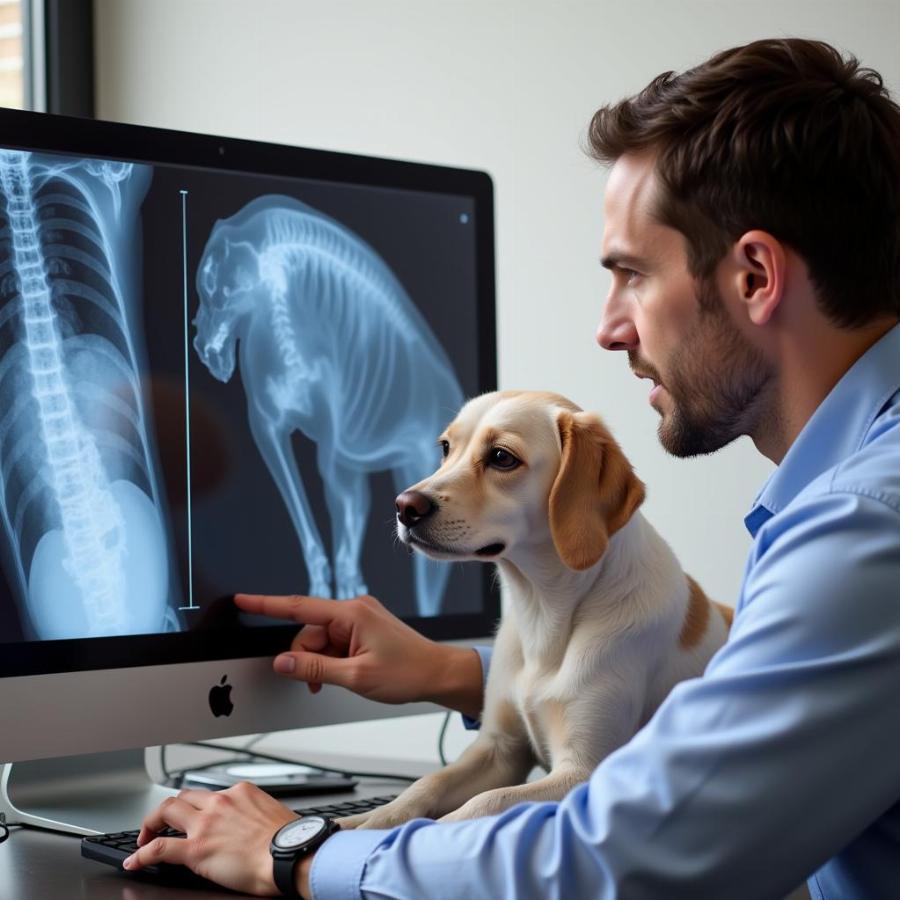X-rays of dogs are a common diagnostic tool used by veterinarians to diagnose and monitor a wide range of medical conditions. While the thought of your furry friend needing an x-ray can be concerning, understanding their purpose and what the images reveal can help alleviate some worries. This comprehensive guide will explore the reasons behind x-rays for dogs, the process involved, and what to expect during and after the procedure.
Why Might My Dog Need an X-ray?
Veterinarians utilize x-rays, also known as radiographs, for a variety of reasons. These images provide valuable insights into your dog’s internal structure, allowing veterinarians to visualize bones, organs, and tissues. Some common situations where an x-ray might be necessary include:
- Suspected Fractures or Bone Issues: X-rays are the gold standard for diagnosing broken bones, dislocations, and other orthopedic problems.
- Respiratory Concerns: If your dog exhibits persistent coughing, difficulty breathing, or other respiratory symptoms, an x-ray can help identify potential causes like pneumonia, lung tumors, or heart enlargement.
- Gastrointestinal Problems: X-rays can aid in diagnosing swallowing issues, blockages in the digestive tract, or the presence of foreign objects.
- Urinary Tract Evaluation: X-rays can reveal bladder stones, tumors, or structural abnormalities in the kidneys or bladder.
- Pre-Surgical Planning and Post-Operative Monitoring: Before procedures, x-rays provide crucial information about the area being operated on. They also assist in monitoring healing progress after surgery.
What Happens During a Dog X-ray?
The process of taking an x-ray of a dog is generally quick and painless, although it may vary slightly depending on the area being examined.
- Positioning: The veterinary team will carefully position your dog on the x-ray table. Depending on the type of x-ray needed, your dog may lie on their side, back, or stand.
- Restraint: Gentle restraint might be required to keep your dog still during the x-ray. This ensures clear images. In some cases, sedation might be necessary, especially for x-rays requiring extended stillness.
- Image Capture: Once your dog is properly positioned, the veterinary technician will step behind a protective barrier and activate the x-ray machine. The x-rays pass through your dog’s body, creating an image on a special film or digital sensor.
Understanding Your Dog’s X-ray Results
After the x-ray is taken, the veterinarian will carefully examine the images, looking for abnormalities or areas of concern.
- Bone Density and Structure: X-rays clearly show bone density, helping identify fractures, arthritis, or bone diseases.
- Organ Size and Shape: The veterinarian can assess the size, shape, and position of organs like the heart, lungs, liver, and kidneys.
- Foreign Objects: X-rays can often detect swallowed objects, helping guide treatment plans for removal.
“It’s important to remember that x-rays provide a two-dimensional view of a three-dimensional structure,” says Dr. Emily Parker, a board-certified veterinary radiologist. “Sometimes, additional imaging, such as an ultrasound or CT scan, may be recommended for a more detailed evaluation.”
 Veterinarian Explaining X-ray
Veterinarian Explaining X-ray
FAQs about Dog X-rays:
Are x-rays safe for dogs?
X-rays use a small amount of radiation, but the risk to your dog is minimal, especially when proper safety protocols are followed. Veterinarians use protective equipment and limit radiation exposure as much as possible.
How much does a dog x-ray cost?
The cost of x-rays for dogs can vary based on factors like the area being x-rayed, the need for sedation, and your geographic location. It’s always wise to discuss costs with your veterinarian beforehand.
Can I be in the room with my dog during the x-ray?
For safety reasons, owners are typically not allowed in the room during x-ray exposure. However, you may be able to be present for positioning if your dog is calm and the situation allows.
How long does it take to get x-ray results?
In most cases, your veterinarian can review the x-ray images and discuss the findings with you shortly after the procedure.
Need More Information About Dog Health?
At Beaut Dogs, we’re committed to providing dog owners with reliable and comprehensive information about all aspects of canine care. From understanding diagnostic procedures like x-rays to offering guidance on nutrition, training, and overall well-being, we’re here to support you every step of the way.
For personalized advice and answers to your specific questions, don’t hesitate to reach out to us at [email protected]. Beaut Dogs is your trusted source for expert insights and compassionate care for your furry companion.